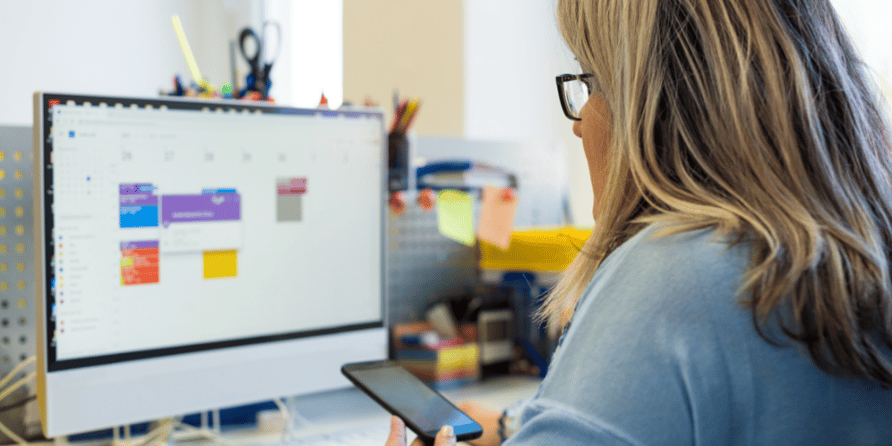
Originally posted November 2022, updated June 2023.
Patient self-scheduling is becoming more of the norm in healthcare, with more and more healthcare providers embracing it for their practices. According to a recent survey, 8 in 10 healthcare consumers said setting up appointments online would make scheduling much easier. And 79% said they want to use patient scheduling software tools to book and manage their healthcare appointments online.
Despite widespread consumer interest in patient appointment scheduling, buy-in is relatively slow for healthcare organizations. A vast majority of healthcare organizations said 20 percent or fewer of their appointments are booked online directly by patients. This is a missed opportunity for practices and providers to not only align with modern consumer preferences but also boost patient engagement in the process.
Let’s discuss the link between patient self-scheduling and engagement, plus how it impacts health outcomes for the better.
The Relationship Between Patient Appointment Scheduling & Engagement
Patient appointment scheduling—executed the right way, with the right technology—directly correlates with higher patient engagement and satisfaction by:
Aligning with Consumer Needs
Healthcare consumers have made something very clear: They’re looking for convenience, flexibility, and autonomy from their healthcare providers. Accurate scheduling with real-time availability directly aligns with modern consumer expectations, improving patient satisfaction, loyalty, and retention—not to mention engagement.
Plus, effectively aligning with healthcare consumer needs helps attract new patients and drives practice growth. It’s truly a win-win!
Putting Patients in the Driver’s Seat
In addition to accommodating today’s healthcare consumers, self-scheduling also puts patients in the driver’s seat, encouraging them to be involved and proactive when it comes to their own care. Self-service tools that display appointment slots for scheduling boost engagement by simplifying appointment management processes and making the care experience easy, efficient, and accessible for patients.
Encouraging Healthier Behaviors
Engaged patients are more likely to be adherent, make healthy lifestyle choices, and follow provider recommendations. What’s more, simplifying the scheduling process improves individual health outcomes by not only boosting patient engagement but also eliminating unnecessary obstacles that lead to delays in care.
Improving Patient Appointment Scheduling with Patient Engagement Technology
Online appointment scheduling is incredibly beneficial for patients, providers, and practices alike—but only when it’s done the right way.
It’s not at all uncommon for practices to offer the option schedule appointments online under the guise of on-the-spot scheduling. While this is (probably) preferable to having no online scheduling functionality whatsoever, it’s not quite what patients are looking for in a healthcare experience.
How can patient scheduling be improved? Patient engagement technology—and optimally, a full patient engagement platform rather than simply a one-off scheduling tool—is key. When evaluating a patient engagement platform for appointment management and beyond, make it a point to look for:
Real-Time Patient Online Scheduling
Look for a solution that provides on-the-spot appointment scheduling through your practice’s website and patient portal as well as other channels such as Google, Facebook, Yelp, and Healthgrades. When booking online, established patients should be able to see providers’ real-time availability and types of appointments, as well as physician bios and other relevant information.
Make the process as convenient as possible, allowing patients to access online scheduling 24/7 on their preferred device without requiring them to download an app or log into an account. Eliminating these barriers will allow for a smooth and easy scheduling experience that both patients and administrative staff will appreciate.
Patient Waiting Lists
Unless the appointment is for a preventative visit, often patients need to see a doctor due to an acute issue. In addition to reserving blocks of time for same-day appointments, it can be useful for healthcare providers to offer placement on an appointment waiting list.
Automated waiting lists can be triggered when a patient cancels an appointment, reaching out to patients that may prefer a sooner time than their original time slot, or during a different time of day, such as an afternoon appointment. Not only do automated waiting lists decrease open slots in the daily schedule and preserve revenue, but they also greatly decrease the administrative tasks required to fill a cancelled appointment.
Automated Appointment Reminders
Don’t stop at patient self-scheduling—embrace automation for patient reminders as well. Automated appointment confirmations allow you to send reminders via each patient’s preferred communication method, whether it’s a confirmation email, text, or phone call.
Implementing automatic appointment reminders helps reduce no-show appointments, maximizing providers’ schedules and eliminating manual outreach. Without the need to manually reach out to each patient via phone to remind them of an upcoming appointment, administrative staff can stop playing a constant game of phone tag and start spending time on less tedious, more meaningful work.
Seamless Two-Way System Integration
Your patient engagement technology should also integrate seamlessly and directly with your electronic health record and practice management systems. Two-way API integration mirrors your practice’s scheduling rules and makes it possible to fill provider openings with greater accuracy and efficiency.
Because information flows freely from one solution to another with direct integration, practices can avoid double booking and unwelcome scheduling mishaps. Additionally, an integrated platform allows multiple solutions to work together in harmony, meaning your practice can also automatically trigger the patient intake process, speeding up the visit stage of the healthcare journey for patients and providers.
Embracing patient scheduling software is just one way healthcare practices can align with healthcare consumerism while also simplifying workflows. Want to learn other ways your practice can streamline operations? Download our eBook, The Complete Guide to Simplifying Practice Workflows, to find out more.


